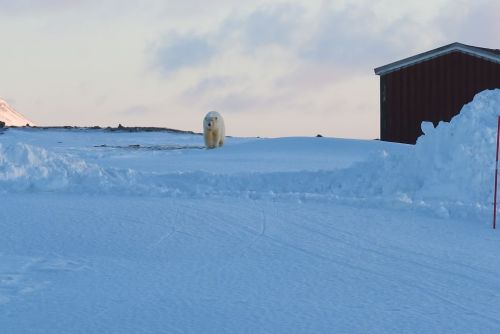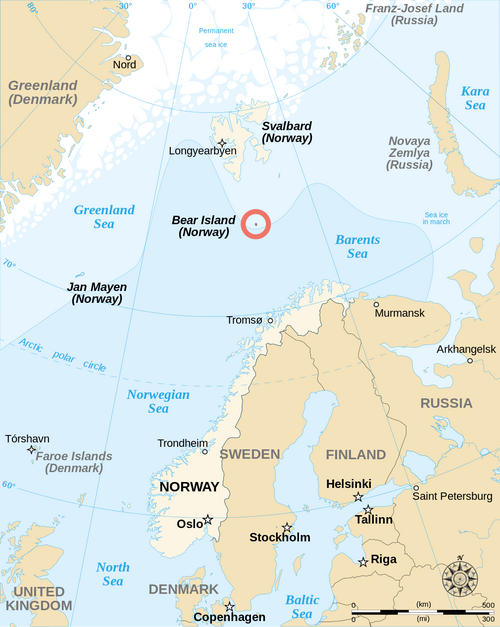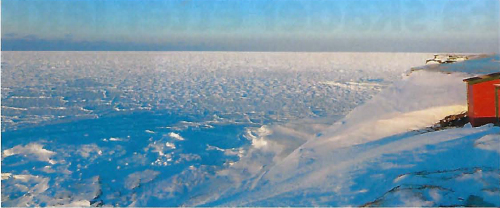Polar bear noticed on Bear Island (Barents Sea) this winter for the primary time in eight years

Reposted from Polar Bear Science
Posted on July 31, 2019 |
Polar bear noticed on Bear Island (Barents Sea) this winter for the primary time in eight years
A polar bear was noticed this 12 months on Bear Island (Bjørnøya) within the southern Barents Sea on eight March by the crew on the Meteorological Station. The final time these employees had seen a polar bear was 2011 however this 12 months in depth Barents Sea ice actually introduced a bear to their doorstep, much like the way in which that sea ice brings bears to southern Labrador and Newfoundland in late winter and spring.

After below-average ice cowl round Svalbard for a lot of the winter months of January and February, by early March the ice had expanded to this point to the south it reached Bjørnøya. It was the type of ice that hadn’t been seen in a long time and nearly instantly, a polar bear was noticed on shore. Given the size of time that the ice surrounding the island continued, it’s probably extra bears got here ashore however weren’t seen: the Meteorological Station on the north finish of the island is the one place that folks dwell over the winter (see maps beneath).
The ice situations that convey polar bears to Bjørnøya are fairly easy: no ice in late winter, no bears onshore.


As I mentioned in a earlier publish, the pack ice descended on Bear Island Three-Four March, a couple of days earlier than the bear was seen on the north coast. The Meteorological Station is positioned on the north finish of the island (discover the star on the map beneath):


In line with a report revealed within the weekly newspaper Svalbardposten (21 March 2019), the crew of the Meteorological Station have been simply settling in to look at a movie on the night of Friday eight March. They’d arrange to make use of a mound of snow as a makeshift projection display screen when a polar bear stood up on it (see photograph beneath), inflicting the crew to resolve to maneuver inside to look at their film!


The photographs present a bear in good situation for early March: considerable new child Arctic seals (which polar bears depend on to replenish fats misplaced over the winter and to fatten up forward of summer season) was nonetheless many weeks away at that time within the season.
A number of days later (as proven within the Norwegian Ice Service ice chart beneath), the island was surrounded by ice that stayed till 21 March or so:


Nick Hughes, who heads the Meteorological Institute, informed Svalbardposten that ice situations at mid-March have been nearly ‘regular’ (i.e. as that they had been earlier than 2007), see photograph beneath. This was not unfastened floes however consolidated pack ice. He stated there was stable ice round Bear Island yearly till 2006 however after that ice solely reached the island in a couple of years (2009, 2011, and 2013) and even then remained for under quick durations (he doesn’t specify how quick). There was apparently ice for just a few days in 2018.


Station supervisor Ragnar Sansteba, who has been on the island since 2007, noticed one bear in 2008 (that maybe arrived on an remoted ice floe), a number of in 2009, two in 2010 and 7 in 2011. He additionally noticed bear tracks (however no bear) in 2013.
Oddly, over the previous few years when this phenomenon has occurred in Labrador and Newfoundland (particularly in 2017), not less than one polar bear specialist in addition to others have been fast accountable sighting of polar bears ashore in late winter and early spring on one thing known as ‘failed’ sea ice – even when this might not have been farther from the reality (ice was in depth, thick, and was nonetheless current into June).
In distinction, this 12 months sea ice round Newfoundland got here later, was a lot much less in depth, much less concentrated, and current for a shorter time period throughout spring than it was in 2017, and polar bear sightings onshore have been a lot much less widespread. I heard of just a few in early spring, see right here, right here, and right here, and some later within the season (Might), right here, right here, and right here, in comparison with nearly two dozen in 2017 (Crockford 2018, 2019a, 2019b). That might recommend much less in depth and fewer concentrated ice offshore in spring on the east coast of Canada ends in fewer bears onshore, no more.
In different phrases, when ice brings a wholesome polar bear inhabitants into contact with land, a couple of curious bears are nearly sure to go exploring.
Or, as Bear Island station supervisor Ragnar Sansteba is quoted as saying:
“…with the ocean ice comes the polar bear wandering.”
References
Crockford, S.J. 2018. State of the Polar Bear Report 2017. World Warming Coverage Basis Report #29. London. Pdf right here.
Crockford, S.J. 2019a. State of the Polar Bear Report 2018. World Warming Coverage Basis Report 32, London. pdf right here.
Crockford, S.J. 2019b. The Polar Bear Disaster That By no means Occurred. World Warming Coverage Basis, London. Obtainable in paperback and e book codecs.
Like this:
Loading…